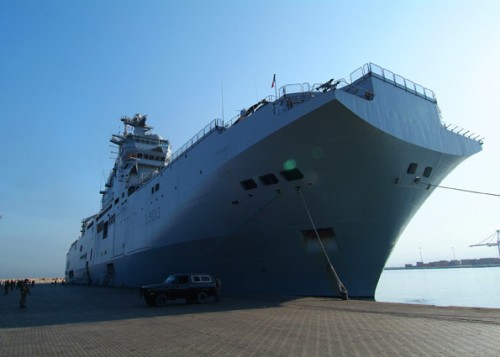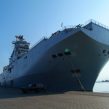
Mistral-Class Ships To Strengthen Russia Over Maritime Neighbors
Publication: Eurasia Daily Monitor Volume: 8 Issue: 123
By:

A power projection tool by definition, Mistral-class ships would give Russia an unprecedented offensive capability, with potentially intimidating effect opposite small and poorly armed maritime neighbors. Designed and equipped for coastal assault, ships of this class could support Russian ground forces in various contingencies in nearby theaters. Russian deployment of such ships in the Baltic or Black Sea in peacetime could significantly complicate the defense planning of NATO and US-allied countries there.
Specialized in amphibious and helicopter-borne troop landing, Mistral-class ships are considered the most modern and effective for such missions in any European navy. Thus, Russia is buying a state-of-the art capability to replace its own, rudimentary and worn-out landing ships.
A Mistral-class ship carries on board four air-cushioned craft, or two hovercraft, to land troops ashore; 16 to 20 helicopters (combat and/or troop-carrying, the mix depending on the mission) for ship to shore attack, with up to 220 air wing personnel; 13 battle tanks and/or 60 armored vehicles (mix depending on mission); up to 900 ground troops with their full armaments, and a floating hospital. The ship has a crew of 160, displacement of 22,000 tons, hull length of 210 meters, top speed of 19 knots, and fuel endurance of up to 11,000 miles at a cruising speed of 15 knots, according to its main builders, Direction des Constructions Navales (DCNS) and the STX shipyard (www.dcnsgroup.com; www.stxeurope.com, June 17, 19).
The numbers of vehicles and personnel aboard the Mistral are flexible, with lower loads for long-term or distant missions, and conversely packing more power for short-term, short-distance missions. The latter would be the case in the Baltic and the Black Sea. There, these ships would be operating for Russia within short distance of the home ports, whether in peacetime or in crises.
The Russian military intends to put its own Ka-52 attack helicopters and Russian landing craft aboard these ships. Specially adapted versions of these helicopters and landing craft are expected to be ready by the time France delivers the two ships in 2014 and 2015 (Interfax, June 17; Nezavisimaya Gazeta, June 21). There are no public indications from Moscow (or elsewhere) about the type of armored vehicles to be carried on board.
France has built two Mistral-class ships for use in distant expeditionary operations (mainly Africa and the Middle East), separately from ground forces (whether French or allied). For Moscow, however, the acquisition of Mistral-class ships must be primarily relevant in the “near abroad,” and in conjunction with Russia’s ground forces.
Russia’s Baltic and Black Sea Fleets are integrated with the respective ground-force commands, and assigned to support land operations in hypothetical crises involving neighboring countries. Mistral-class ships would undoubtedly be tasked for the same possible role, if Russia deploys them in the Baltic and Black Sea.
Mistral-class ships would give Russia a capability to land troops on thinly defended coasts, particularly of small nations with weak militaries, no air power, and long coastlines, in hypothetical crisis situations. The three Baltic States and Georgia, for example, are all facing Russia both on land and at sea. They would face additional risks, if Russia deploys its new ships equipped for coastal assault in proximity to these countries.
Lacking a modern capability of this type, Russia decided to acquire Mistral ships after invading Georgia in 2008 with ground forces. Moscow concluded that its ground operation could have been more effective, if supplemented with a rapidly executed landing on Georgia’s Black Sea coast. Russia attempted such a landing, but its obsolete ships failed to execute it in time for making a difference in the five-day war. Had that landing succeeded, Russia would have opened a second front, moving into Georgia from the west while the main Russian force was attacking in the east.
With Mistral-class ships, Russia’s Baltic or Black Sea Fleet would gain the ability to land troops onshore quickly and seize coastal footholds during hypothetical crises. This potential threat (whether carried out or not) could pressure a target country from the direction of the sea during a crisis, adding to the main pressure along the land border. Thus, Russia could compel small, thinly defended countries to divide meager resources between land defense and coastal defense. Moscow can use these tactics also in peacetime, short of any crisis, by adding Mistral-class ships to its Baltic or Black Sea Fleet. In that case, NATO and the US would be called upon to strengthen the defense capacities of potentially exposed allies.




